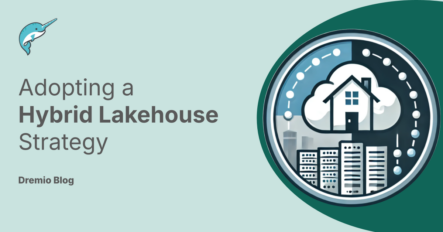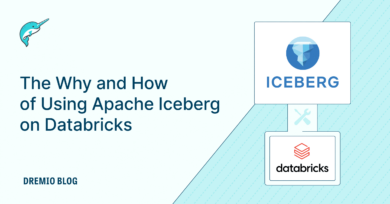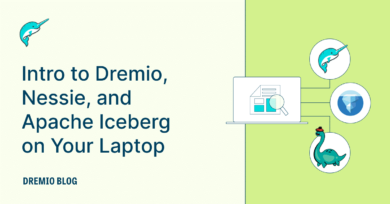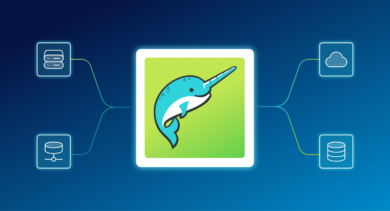8 minute read · December 19, 2024
Adopting a Hybrid Lakehouse Strategy
· Principal Product Marketing Manager

Enterprises have revolutionized analytics by leveraging the cloud’s scalability and flexibility. Yet, despite the promise of the cloud, many organizations find that a cloud-only strategy doesn’t always meet their performance, cost, or governance expectations. As the complexities of multi-cloud and hybrid data environments grow, it’s time to consider a hybrid lakehouse strategy that combines the strengths of both on-premises and cloud data infrastructures to address these challenges and unlock the full potential of enterprise analytics.
This blog explores insights from Analyst David Loshin of Knowledge Integrity’s white paper, "It's Time to Consider a Hybrid Lakehouse Strategy,” which looks into how organizations can benefit from this innovative data management and analytics approach.
The Evolution of Data Analytics Architecture
Traditional data warehousing has long been the backbone of enterprise analytics, designed to enhance performance by separating operational and analytical workloads. However, this model has limitations:
- Rigid Data Models: Early-defined schemas restrict the inclusion of new data sources and complicate adaptation.
- Dependency on IT Resources: Business users often face bottlenecks due to limited IT support for application development.
- Scalability Challenges: Expanding traditional data warehouses can be costly and cumbersome as data volumes grow.
The advent of Hadoop and its distributed file system (HDFS) marked a turning point, enabling the creation of data lakes that store vast datasets in raw form. These data lakes empowered greater flexibility and self-service for data users. Cloud computing amplified this paradigm, offering virtually unlimited storage and decoupled compute and storage resources. Yet, data lakes also introduced their challenges, such as governance and usability.
From Data Lake to Lakehouse
Enter the data lakehouse—an architecture that combines the scalability of data lakes with the structure, governance, and transactional consistency of data warehouses. In a lakehouse, datasets are presented as tables with ACID (atomicity, consistency, isolation, durability) guarantees, supported by integrated metadata catalogs for simplified data access and management. This model bridges the gap between raw data storage and user-friendly analytics, enabling flexibility and reliability.
The Case for a Hybrid Strategy
While cloud-based lakehouses offer compelling advantages, a cloud-only approach often fails to address critical enterprise needs. Here are some key considerations driving the shift toward hybrid lakehouses:
- Cost Management Many organizations underestimate the total cost of cloud operations. While cloud storage fees may seem low initially, hidden costs such as data transfer, egress fees, and API access charges can quickly escalate. A hybrid approach allows enterprises to store frequently accessed data on-premises, minimizing recurring cloud costs.
- Avoiding Vendor Lock-In proprietary cloud-only solutions can limit innovation and scalability, creating dependency on specific vendors. A hybrid lakehouse built on open standards like Apache Iceberg provides flexibility and vendor independence, enabling organizations to adapt their infrastructure as needed.
- Performance Optimization Distributed data across multi-cloud environments can lead to latency issues, impacting application performance. Storing data near where it’s used—whether on-premises or in the cloud—enhances speed and reduces network bandwidth constraints.
- Governance and Compliance With increasing regulations around data privacy, sovereignty, and security, hybrid strategies allow organizations to retain sensitive data on-premises while leveraging the cloud for less regulated datasets. Centralized governance frameworks further ensure compliance across the hybrid environment.
- Flexibility and Scalability A hybrid lakehouse architecture supports evolving business needs, allowing organizations to dynamically scale data storage and analytics capabilities. Open standards enable seamless interoperability across diverse tools and platforms.
Designing a Hybrid Lakehouse Architecture
Building a hybrid lakehouse requires careful planning and the right technology components. Here are some best practices:
- Adopt Open Standards Technologies like Apache Iceberg provide a robust foundation for hybrid lakehouses, ensuring transactional consistency, schema evolution, and compatibility with various storage and compute platforms.
- Implement an Enterprise Data Catalog A data catalog acts as the backbone of a hybrid lakehouse, enabling centralized metadata management, versioning, and access control. This simplifies governance and enhances data discoverability.
- Leverage a Semantic Layer A semantic layer abstracts the complexities of underlying data structures, allowing business users to query data intuitively without needing technical expertise.
- Optimize for Performance Techniques such as data caching, materialized views, and intelligent query acceleration (e.g., Dremio Reflections) improve data access speed and support high-performance analytics.
- Integrate Governance Frameworks Centralized policies for data access, security, and quality monitoring ensure consistent governance across on-premises and cloud environments.
Benefits of Apache Iceberg for Hybrid Lakehouses
Apache Iceberg stands out as a critical enabler of hybrid lakehouses, offering features such as:
- ACID Compliance: Guarantees transactional consistency for reliable analytics.
- Schema Evolution: Tracks table changes over time, enabling flexibility in data management.
- Partitioning and Performance: Supports hidden partitioning and query optimization.
- Cross-Engine Compatibility: Operates seamlessly with multiple query engines and tools.
These capabilities make Apache Iceberg ideal for enterprises seeking to modernize their data infrastructures with hybrid lakehouses.
Conclusion: Unlocking the Future of Data Analytics
A hybrid lakehouse strategy offers the best of both worlds—leveraging the scalability of the cloud and the control of on-premises infrastructures. By addressing the limitations of cloud-only solutions, hybrid lakehouses enable organizations to optimize costs, enhance performance, and ensure robust governance.
Dremio’s Hybrid Iceberg Lakehouse is at the forefront of this transformation, empowering global enterprises with an open, flexible platform for unified data access and analytics. With customers like Maersk, NetApp, and S&P Global, Dremio provides the tools to accelerate insights while future-proofing data strategies. To learn more, download a complete copy of David’s white paper, It’s Time to Consider a Hybrid Lakehouse Strategy.
Contact Dremio to explore how you can leverage a Hybrid Data Lakehouse.
Sign up for AI Ready Data content


